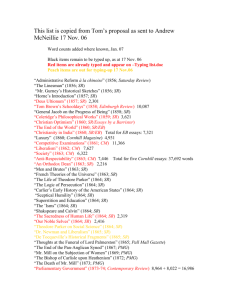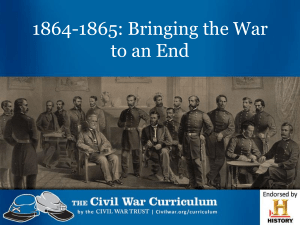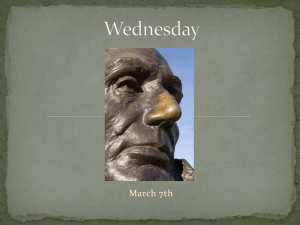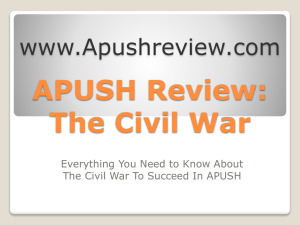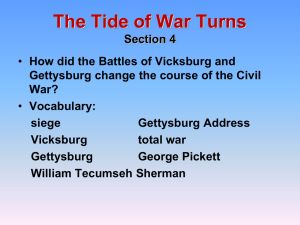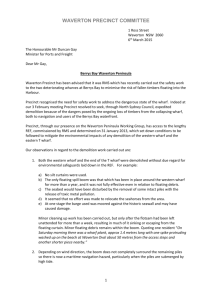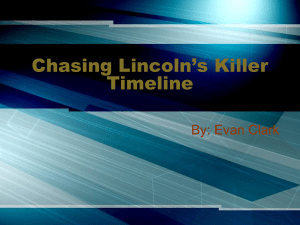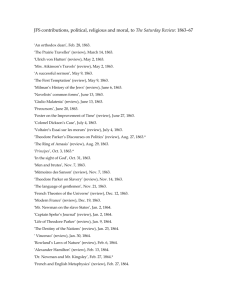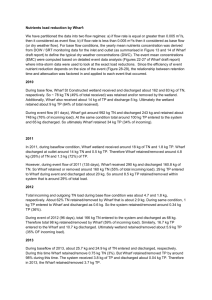Civil War Logistics
advertisement
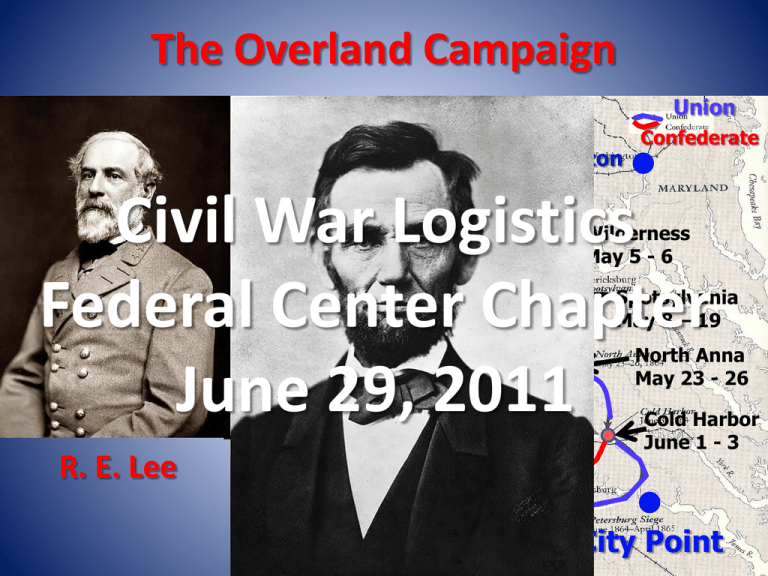
The Overland Campaign Union Washington Confederate Civil War Logistics Federal Center Chapter June 29, 2011 Wilderness May 5 - 6 Spotsylvania May 8 – 19 North Anna May 23 - 26 R. E. Lee U. S. Grant Richmond Petersburg Cold Harbor June 1 - 3 City Point City Point, Virginia “ ‘That’s Logistics’, Long Before UPS” City Point, Virginia The James River Plantation owned by the Epps family for generations. Current owner, Dr. Richard Epps, Confederate surgeon. City Point, Virginia June 1864 Appomattox Manor Original Wharf Grant’s Headquarters Grant in front of his HQ tent Grant’s HQ in the field - 1864 Appomattox Manor Appomattox Manor Damaged during Civil War Bedroom Quartermaster’s Office Dining Room Telegraph Office Construction of Grant’s HQ • Grant wanted to live in tents. He did not want permanent structures built • His objective was to rapidly end the siege, defeat Lee, and win the war • With the oncoming winter, Grant’s staff urged that more permanent structures be built • In November 1864, Grant had to leave City Point for a few days and the construction corps built cabins to house Grant and his staff Building Winter Quarters Grant’s Cabin Bedroom 25’ 9’ Office 14’ Grant is seated at center GRANT’S CABIN Interior of Grant’s Cabin Receiving and Storage Facilities • Eight wharves were built, by commodity, over a mile long and covering 350,000 square feet. They included general supply, forage, ordnance, subsistence, medical, maintenance, mail landing, and transfer • Warehouses over 100,000 square feet were located on the wharves • A plank road and rail lines ran along wharf • Supplies were either put into storage or loaded onto wagons or railroad cars and taken to the front USMRR City Point, VA • Benjamin Epps, father of Dr. Richard Epps who owned the plantation in 1864, built the railroad from the James River to Petersburg in 1836 – 1838 • By 1864 the railroad was in a state of disrepair. Between June 18th and July 7th, 1864, it was rebuilt and delivering men and supplies between City Point and the front lines • USMRR expanded the rail lines from 9 miles to 22 miles to support the Union armies • At its height up to 24 locomotives pulled an average of 1400 tons of supplies, and troops to the front each day and returned with sick and wounded U S Military Railroad (USMRR) & Wharves Commissary Depot & Bakery Ingalls HQ Grant HQ Stables Hospital 1 2 Main Rail line 4 6 Ordnance Wharf 7 8 Mail 3 Forage Wharf 5 Transfer Wharf Commissary Wharf Railroad Track and Storage Facilities Shipping into City Point • More than 390 ships routinely connected Union supply sources with City Point • At any time, approximately 40 steamships and tugs, 75 sailing ships, and 100 barges were in service at Eastern ports, en route, or anchored at City Point • Up to 25 ships could be offloaded at one time at the wharves Ships Offloading at City Point African-Americans Receiving Supplies Most stevedores were freed slaves Supply Support at City Point • Over 280 buildings were erected at City Point • In the nine months City Point was open, over 600,000 tons of supplies were delivered from the wharves and warehouses to the front lines • A daily transaction report was submitted to Quartermaster General Rufus B. Ingalls listing receipts and issues Quartermaster Depot Outside Storage Ordnance Wharf and Lumber Storage Supply Support at City Point • Supply support was on a “pull” system • Requirements were consolidated at regimental level • Commanding Generals of the two armies signed the requirements • Quartermaster Generals of both armies submitted a detailed listing of requirements on the 25th of the month for the following month • Ingalls and his staff checked for availability, submitted requisitions for items not available, and planned deliveries to support monthly requirements • Ingalls insisted on accountability. Nothing left City Point without his authorization Rail Deliveries from City Point • Supplies were delivered by rail from the depot directly to brigade supply areas, nine round trip runs each day • Response time for routine requests dropped to less than 24 hours and to several hours for emergencies Wagon Train Deliveries from City Point What wasn’t delivered by rail was delivered by wagon Subsistence Support • Most likely the best fed army up to that time, certainly in the Civil War • Commissary wharf – 581 ft long and 40,000 square feet • One herd of cattle numbering 2500 was maintained at City Point. Another herd of 2500 was maintained across the James River • Fresh meat and vegetables were provided to the troops when available • Bakery produced 100,000 loaves of bread per day • Requirement for storage of 16,000 tons of food for troops (30 days) and 17,000 tons for animals (20 days) at all times Slaughterhouse at City Point Menu Items • Menus included the following: salt pork, fresh beef, ham and bacon, hard bread, soft bread, potatoes, onions, flour, beans, split peas, rice, dried apples, desiccated vegetables, coffee, tea, sugar, molasses, vinegar, pepper and salt • Wagons with fresh produce , when available, were driven down the lines Thanksgiving Day 1864 • Businessman George Blunt raised money to provide Thanksgiving dinner to the troops • Coordinated by New York Union Club cofounder Theodore Roosevelt, Sr. • Delmonico’s and other NYC restaurants provided thousands of dinners of turkeys and other fowl with all the trimmings. • Results were mixed • Primary benefit was morale Thanksgiving 1864 “our defenders, City Point” Maintenance and Repair • Repair depot commander: Brevet LTC E. J. Strang • Repair depot workforce numbered over 1,800 carpenters, wheelwrights, blacksmiths, saddlers, teamsters and corral hands • Repair depot wharf covered 190 feet of waterfront and consisted of 26,000 square feet of storage space Maintenance and Repair (cont.) • In nine months of operation, the depot repaired 3,653 wagons and 2,414 ambulances • 19,618 horses and 31,628 mules were shod • Department issued 31,386 horses, 18,891 mules, 1,536 wagons and 370 ambulances • Colonel Strang provided repair teams of blacksmiths, carpenters and wheelwrights to front line units to shoe animals and repair equipment Maintenance Facilities • Repair shops at City Point maintained and repaired over 5,000 wagons and 60,000 animals that supported Grant’s armies USMRR Roundhouse and Repair Facility Hospital Facilities • City Point Hospital covered two hundred acres • Hospital handled more than 10,000 patients during summer of 1864 • Twelve hundred tents lined the streets • Capable of providing 6,000 patients warm quarters during winter of 1864 – 1865 in 90 (20’ X 50’) log huts City Point Hospital Hospital Ambulances Hospital Facilities • Drugs and medical supplies were plentiful • Patients had a bed with clean sheets and pillows • Hospital featured running water and laundry facilities – 2 four HP steam engines pumped water Steam Engines at the City Point Dock Defense was critical Confederate lines were close by and there was always the threat of cavalry raids Three significant attacks were made on City Point Entrenchments at City Point st 1 Attack on City Point • On August 9, 1864 – an explosion shook City Point – A munitions barge at the wharf exploded – Estimated 75,000 rounds of small arms ammunition and 20,000 rounds of artillery ammunition exploded – At least 43 killed and 126 wounded – Destroyed several large buildings and 180 feet of wharf – Two million dollars worth of supplies and munitions were destroyed st 1 Attack on City Point • August 9, 1864 (cont.) ● Grant could have been a casualty. Several of his staff surrounding him were wounded ● Grant did not even get up to see what had happened. After it was over, he received a report and went directly to the telegraph office to report the incident ● City Point was back to nearly full operation in nine days Another View of the Devastation Note: Rail cars and The incident was considered wagon train years along the wharf an accident until seven later. A former Confederate agent, John Maxwell, admitted to setting a time bomb, which he called a “horological torpedo” Ordnance Wharf with Sentry nd 2 Attack on City Point September 17, 1864 ● Lee learned of cattle movement by tapping Union telegraph lines between City Point and Washington ● Wade Hampton’s cavalry stole 2,500 head of cattle and delivered them to Lee’s army rd 3 Attack on City Point • January 25, 1865 – Three ironclads, three wooden vessels and flotilla of torpedo boats headed down the James River towards City Point – Objective: Run past the batteries, take City Point and cut off Union supply lines – A large Confederate force was massed north of the river to attack once City Point was reached Attacks on City Point • January 25, 1865 (cont.) – The ships got past the batteries of guns – The ironclads ran aground and the other boats turned back • The attack was a total failure – If it had been successful, Union armies would have temporarily been cut off from supplies – If Lee had taken City Point, even for a short time, stolen supplies would have resupplied his army for months President Abraham Lincoln Visit to City Point, VA March 24 – April 9, 1865 • After his wife’s suggestion, Grant invited President Lincoln to visit City Point on March 20, 1865 • Lincoln arrived at City Point on March 24, 1865 President Abraham Lincoln Visit to City Point, VA March 24 – April 9, 1865 ● Lincoln visited units and patients in military hospitals ● While at City Point, Lincoln was in constant communication with the government in Washington via telegraph ● A meeting between Lincoln and his major commanders, General Grant, General Sherman and Admiral Porter was held on the “River Queen,” on March 28th “The Peacemakers” George P. A. Healy President Abraham Lincoln Visit to City Point, VA March 24 – April 9, 1865 • President Lincoln visited Richmond, two days after its capture on April 4, 1865 • Lincoln left City Point to return to Washington on April 9th, the day Lee surrendered to Grant at Appomattox • He was shot at Ford’s Theater on April 14, 1865 and died the following morning • Lincoln spent two of his last three weeks on earth at City Point City Point’s Legacy • "There has been no army in the United States where the duties of Quartermaster have been so well performed.“ Ulysses S. Grant Commanding General Quartermaster General Rufus B. Ingalls The End Rufus Ingalls’ English Spotted Coach Dog
